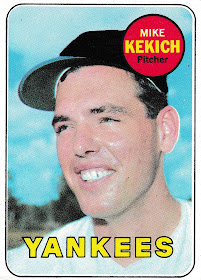This is a late-series 1969 card, showing Jim Gosger in his new Seattle Pilots uniform.
(It’s too bad Topps didn’t think ahead, and put all the expansion team players in the later series, so they had time to get good photos of all the players.)
Gosger was signed by the Red Sox in 1962, and made his big-league debut with the Sox in May 1963. He played in 19 games that season, mostly as a pinch-hitter or pinch-runner, although he made 2 starts in center field in the season’s final week.
Jim was back in the minors for all of 1964 and the first half of 1965. Beginning on July 9th, he made 19 consecutive starts in center field (replacing
Lenny Green), then moved over to right field for the 18 of the next 20 games, while
Tony Conigliaro was out of the lineup. When Tony C. returned to the lineup on 8/20, Gosger moved back to center field for the final 42 games. All told, he started 79 of the final 81 games after his recall.
For the first two months of the 1966 season he alternated in center field with Green and
George Thomas, then was traded to the Athletics (with pitchers Guido Grilli and Ken Sanders) for outfielder
Jose Tartabull and pitchers
John Wyatt and
Rollie Sheldon. That year, left and center fields were a carousel for the Athletics (with only right fielder
Mike Hershberger getting regular playing time). Jim split his time between left and center fields, sharing the starts with
Joe Nossek,
Roger Repoz,
Larry Stahl, and
Danny Cater.
Hopefully he made the most of that 1966 mish-mash, because
Rick Monday joined the squad in 1967, taking over the center field job in game #10 and for several years thereafter. Gosger was the team's 3rd outfielder in terms of innings played, but he was backing up at all three spots (with Cater starting more in left field than Gosger).
His playing time decreased even more in 1968.
Reggie Jackson was in his first full season, moving Hershberger over to share left field with rookie
Joe Rudi, and sending Gosger to the bench.
Jim was selected by the Seattle Pilots in the October 1968 expansion draft, and was the team's starting center fielder for 10 of the first 14 games. He was soon replaced by
Wayne Comer, and by mid-season was sent to the Mets in exchange for Greg Goossen.
He spent the rest of the season in triple-A, only returning to the Mets for 10 games in September, and was not on the Mets' post-season roster.
After the 1969 season Gosger was traded to the Giants for pitcher
Ray Sadecki and outfielder
Dave Marshall, but before playing any games for San Fran, he was acquired by the Expos in late-April 1970.
For 1970 and 1971, Jim played parts of both seasons with the Expos while also spending a lot of time with their AAA team.
After the 1971 season he was traded back to the Mets for 4 minor-league players. He played for the Mets' AAA team from 1972-74, while also appearing in a few dozen games for New York in '73 and '74.
Gosger was released on 10/1/74 (
the Mets didn't waste any time!) ending his 10-year career.
Although very much alive, last year the Mets mistakenly included him in
a video honoring deceased ex-Mets.

























